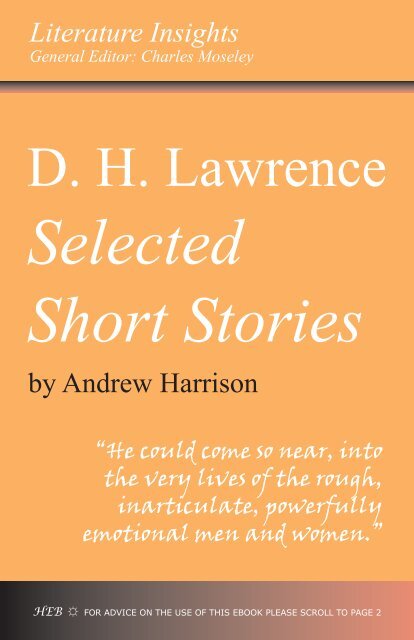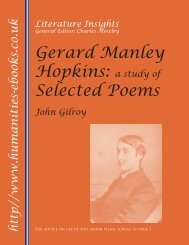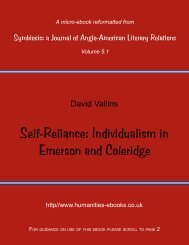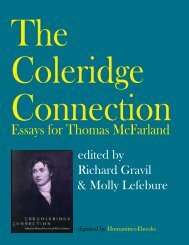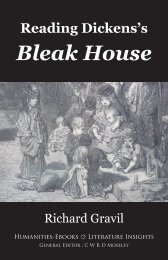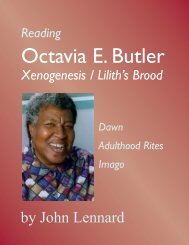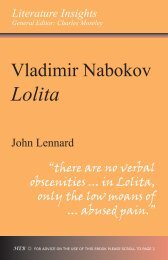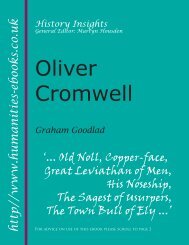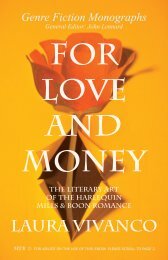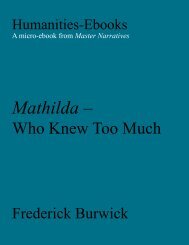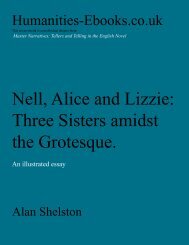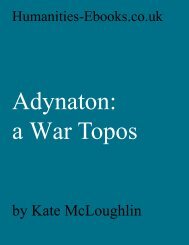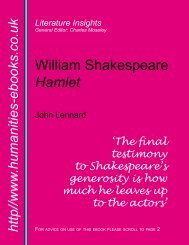DH Lawrence: Selected Short Stories - Humanities-Ebooks
DH Lawrence: Selected Short Stories - Humanities-Ebooks
DH Lawrence: Selected Short Stories - Humanities-Ebooks
Create successful ePaper yourself
Turn your PDF publications into a flip-book with our unique Google optimized e-Paper software.
Literature Insights<br />
General Editor: Charles Moseley<br />
D. H. <strong>Lawrence</strong><br />
<strong>Selected</strong><br />
<strong>Short</strong> <strong>Stories</strong><br />
by Andrew Harrison<br />
“He could come so near, into<br />
the very lives of the rough,<br />
inarticulate, powerfully<br />
emotional men and women.”<br />
HEB ☼ FOR ADVICE ON THE USE OF THIS EBOOK PLEASE SCROLL TO PAGE 2
Copyright<br />
© Andrew Harrison, 2008<br />
The Author has asserted his right to be identified as the author of<br />
this Work in accordance with the Copyright, Designs and Patents<br />
Act 1988.<br />
First published by <strong>Humanities</strong>-<strong>Ebooks</strong>, LLP,<br />
Tirril Hall, Tirril, Penrith CA10 2JE<br />
Reading t<br />
* This book is designed to be read in single page view, using the<br />
‘fit page’ command.<br />
* To navigate through the contents use the hyperlinked ‘Bookmarks’<br />
at the left of the screen.<br />
* To search, click the magnifying glass symbol and select ‘show<br />
all results’.<br />
* For ease of reading, use to enlarge the page to full<br />
screen, and return to normal view using < Esc >.<br />
* Hyperlinks (if any) appear in Blue Underlined Text.<br />
Permissions<br />
Your purchase of this ebook licenses you to read this work onscreen.<br />
No part of this publication may be otherwise reproduced or<br />
transmitted or distributed without the prior written permission of both<br />
the copyright owner and the publisher. You may print one copy of<br />
the book for your own use but copy and paste functions are disabled.<br />
Making or distributing copies of this book would constitute copyright<br />
infringement and would be liable to prosecution. Thank you for<br />
respecting the rights of the author.<br />
ISBN 978-1-84760-073-8
D. H. <strong>Lawrence</strong>:<br />
<strong>Selected</strong> <strong>Short</strong> <strong>Stories</strong><br />
Andrew Harrison<br />
Tirril: <strong>Humanities</strong>-<strong>Ebooks</strong>, 2008
Contents<br />
The Author<br />
Acknowledgements<br />
Note on Texts<br />
Chapter 1: Introduction<br />
1.1 Early Realist <strong>Stories</strong><br />
1.2 Modernist Tales<br />
1.3 Late Fables and Satires<br />
Chapter 2: Reading the <strong>Short</strong> <strong>Stories</strong><br />
2.1 ‘Odour of Chrysanthemums’<br />
2.2 ‘Daughters of the Vicar’<br />
2.3 ‘Love Among the Haystacks’<br />
2.4 ‘The Prussian Officer’<br />
2.5 ‘England, My England’<br />
2.6 ‘The Horse-Dealer’s Daughter’<br />
2.7 ‘The Blind Man’<br />
2.8 ‘The Rocking-Horse Winner’<br />
2.9 ‘The Man Who Loved Islands’<br />
2.10 ‘Things’<br />
Chapter 3: Some Stylistic Features of the <strong>Short</strong> <strong>Stories</strong><br />
3.1 Dialogue<br />
3.2 Symbolism<br />
3.3 Free Indirect Discourse<br />
3.4 Mimicry and Satire<br />
Select Bibliography<br />
Hyperlinked Materials
The Author<br />
Andrew Harrison lectures in English Literature at the Technische<br />
Universität Darmstadt, Germany. He has published numerous<br />
articles on D. H. <strong>Lawrence</strong>, and is the author of D. H. <strong>Lawrence</strong><br />
and Italian Futurism (Amsterdam: Editions Rodopi, 2003), co-<br />
editor (with John Worthen) of a casebook of modern critical<br />
essays on Sons and Lovers (New York: Oxford University Press,<br />
2005), and author of the <strong>Humanities</strong> Insights e-book on Sons and Lovers.<br />
He edits the Journal of D. H. <strong>Lawrence</strong> Studies.
Chapter 1: Introduction<br />
‘Of the shorter forms of prose fiction—short story and longer<br />
tale—<strong>Lawrence</strong> is surely the supreme master’.<br />
F. R. Leavis, D. H. <strong>Lawrence</strong>: Novelist (1955)<br />
D. H. <strong>Lawrence</strong> famously polarises literary critical opinion, and<br />
his reputation as a novelist has fluctuated dramatically since F. R.<br />
Leavis first brought his fictional writings to academic prominence<br />
in the 1950s. His reputation as a poet has been similarly mixed; several<br />
of his poems are often anthologised, but the general consensus<br />
is that he wrote too much poetry, and that his output was (to say<br />
the least) uneven. At the beginning of the twenty-first century, one<br />
is more likely to hear <strong>Lawrence</strong> praised in an academic context for<br />
his travel writings and essays—and for his short stories. Among all<br />
his creative work, only the short stories have escaped the changes in<br />
reputation incident upon the wholesale shifts in critical fashion over<br />
the past half century. Though many today might question <strong>Lawrence</strong>’s<br />
supremacy as a short story writer, few would deny his outstanding<br />
achievements in the genre.<br />
<strong>Lawrence</strong>’s major novels sometimes alienate readers with their ideological<br />
insistence, or their repetitive, rhythmic use of language. The<br />
short stories, by contrast, play to <strong>Lawrence</strong>’s strengths in the acuteness<br />
of their psychological analysis, their powerful use of setting and<br />
symbolism, and their characteristic open-endedness. There is also a<br />
remarkable range to <strong>Lawrence</strong>’s output as a short story writer. For the<br />
purposes of this study guide, and in spite of the complications produced<br />
by <strong>Lawrence</strong>’s continual revision of his fictional works, I have<br />
identified three phases in <strong>Lawrence</strong>’s career as a short story writer:<br />
the early realist short stories, the modernist tales, and the late fables<br />
and satires. In this brief introduction I hope to demonstrate the different<br />
formal and thematic qualities of each phase.
1.1 Early Realist <strong>Stories</strong><br />
D. H. <strong>Lawrence</strong>: <strong>Selected</strong> <strong>Short</strong> <strong>Stories</strong> 9<br />
As a novelist, the key early influences on <strong>Lawrence</strong> were both<br />
English nineteenth-century realists: George Eliot and Thomas Hardy.<br />
The memoirs of his close companion and sometime girlfriend, Jessie<br />
Chambers, show that he was closely contemplating the structure of<br />
Eliot’s plots as he planned out his first novel, The White Peacock<br />
(1911). Hardy helped to focus his thinking about romantic tragedy<br />
and the forces of fate and circumstance.<br />
In the short story, however, the native tradition was far less prominent.<br />
The important early influences on <strong>Lawrence</strong> in this genre<br />
were Russian and French: Anton Chekhov, Maxim Gorky, Guy<br />
de Maupassant, Balzac, and Prosper Mérimée. From these writers<br />
<strong>Lawrence</strong> gleaned insights into the formal art of writing. He found<br />
in the French writers, for instance, a ‘level-headed, fair, unrelenting<br />
realism’ which checked his own early tendency towards melodrama<br />
and sentimentalism. Where he was inclined to use too much informative<br />
dialogue to flesh out characters and themes, and too many adjectives<br />
to introduce a poetic element to his prose, the French realists<br />
relied upon ‘plain description or narrative’, using ‘slight incidents’ to<br />
reveal character.<br />
With the encouragement of his literary mentors, <strong>Lawrence</strong> very<br />
swiftly assimilated the lessons of the enigmatic realist short story in<br />
this nineteenth-century European tradition. Descriptive economy and<br />
attention to small details were vital, and the compression of the narrative<br />
meant that complex themes had to be approached not descriptively,<br />
but through a careful, selective use of dialogue and a focus on<br />
Chambers reported a conversation with <strong>Lawrence</strong> on the subject of the novel in<br />
which he commented that ‘The usual plan is to take two couples and develop<br />
their relationships … Most of George Eliot’s are on that plan. Anyhow, I don’t<br />
want a plot, I should be bored with it. I shall try two couples for a start’. Jessie<br />
Chambers, D. H. <strong>Lawrence</strong>: A Personal Record by E.T. (London: Jonathan<br />
Cape, 935), 03.<br />
In The White Peacock, a young woman named Marie is moved to say: ‘… look at<br />
Hardy—life seems so terrible—it isn’t, is it?’ D. H. <strong>Lawrence</strong>, The White Peacock,<br />
ed. Andrew Robertson (Cambridge: Cambridge University Press, 983), 08. In<br />
9 4 <strong>Lawrence</strong> wrote a lengthy ‘Study of Thomas Hardy’.<br />
3 James T. Boulton, ed., The Letters of D. H. <strong>Lawrence</strong> (Cambridge: Cambridge<br />
University Press, 979), I, 9 .
10 D. H. <strong>Lawrence</strong>: <strong>Selected</strong> <strong>Short</strong> <strong>Stories</strong><br />
significant action. In short, he learned to show, not tell; to approach<br />
emotional extremities through a studied emphasis on the everyday<br />
reality of working-class lives.<br />
One can see the fruits of his apprenticeship to this European realist<br />
tradition in his early short stories ‘Odour of Chrysanthemums’,<br />
‘Daughters of the Vicar’, and ‘Love Among the Haystacks’. All three<br />
concern themselves with the lives of the working classes, using telling<br />
details and incidents to reveal emotional tensions and to establish<br />
social realities.<br />
In ‘Odour of Chrysanthemums’, Elizabeth Bates is first seen calling<br />
her son John into the house from the garden. As he resentfully<br />
advances towards the door, he instinctively tears at a line of ragged<br />
pink chrysanthemums beside the path. His mother upbraids him, but<br />
then she herself breaks off a twig with three or four flowers, holding<br />
it to her face, before placing it in her apron band. The incident<br />
subtly suggests the boy’s irritation, even suppressed anger, at being<br />
called back from play to the scene of the domestic conflict played<br />
out between his parents. The mother’s private gesture with the flowers<br />
hints at a child-like innocence which she keeps firmly hidden<br />
from her children. Later in the story, when her daughter Annie draws<br />
her attention to the beauty of the flowers, she dismisses them with<br />
savage efficiency, seeing chrysanthemums as symbolic of her own<br />
disastrous marriage. The damaging pattern of emotional interactions<br />
between husband and wife, mother and children, is carefully channelled<br />
through the flower symbolism.<br />
We might think of other early stories which similarly use small<br />
incidents to show us the lives of their characters. In ‘Daughters of<br />
the Vicar’, Louisa Lindley visits Quarry Cottage and finds old Mrs<br />
Durant lying in her garden; she has fallen while attempting to pull out<br />
a row of Brussels sprouts for her youngest son’s dinner. The scene<br />
gives us a vivid insight into the domestic economy of this workingclass<br />
household, and into the relationship between Mrs Durant and<br />
the thirty-year-old Alfred, who is working at the pit. Mrs Durant goes<br />
out into the cold to fetch Alfred’s dinner in spite of the pain she has<br />
been feeling from a tumour on the side of her abdomen; her duty<br />
towards her son is the main incentive in her own life, and she even
Is this sample what you are looking for?<br />
If so, please browse our lists<br />
or look for different formats at:<br />
http://www.humanities-ebooks.co.uk<br />
or buy this PDF book<br />
HERE<br />
About <strong>Humanities</strong> <strong>Ebooks</strong><br />
<strong>Humanities</strong>-<strong>Ebooks</strong> is an an authors’ co-operative, not a commercial publisher.<br />
Our aim is to produce inexpensive, high quality <strong>Ebooks</strong>, and to pass the maximum<br />
possible proportion of the purchase price to their authors.<br />
Almost all our titles are available in Kindle format, though for academic books<br />
and those with complex layout the PDF is almost invariably superior.<br />
All our titles can be ordered by libaries through Ebrary, EBSCO and MyiLibrary.<br />
Paperback versions of many of our titles can be reached via the book descriptions<br />
on our website.


